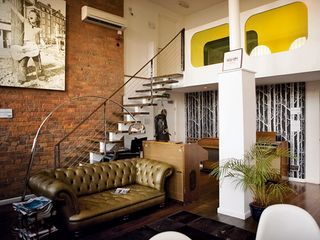In pictures: Blueprint Studios, Salford

Welcome
Best-known as the place where Elbow recorded their Leaders of the Free World and The Seldom Seen Kid albums, Salford’s Blueprint Studios was founded by Tim Thomas, Ian Stewart and Fred Kindt in 2003. As Future Music recently discovered, though, this isn’t just a recording facility: it’s a rehearsal space and live venue, too.

The Big Room
This huge live space got its name when Elbow called it The Big Room when they were recording Leaders of the Free World (it was also the album’s working title). It can hold up to 250 people, making it an intimate gig venue, too (there’s even a bar). Fred Kindt describes the room’s favourable acoustics as “a bit of a fluke”; the
25 metre by 15 metre room had such an appealing natural reverberation that it was only necessary to fit movable floor-to-ceiling drapes in order to fine tune the echoes. “[Elbow} like the sound so much that they recorded an impulse response of the room so they can use it for convolution reverb when they’re away,” says Kindt.

Studio 1
“We chose the Neve VR Legend [console] and we’ve been so happy with it,” says Fred Kindt. “I think we’ve had a lot of business from it too because there aren’t many Neves in the Manchester area.” Discussing monitoring, Kindt says: “The mains are the Genelec 1034s. Young bands especially like hearing it loud but when we start mixing they don’t get used much. We went for the Adam S3As for the midfields and they’re the workhorses. Everyone really trusts them. Then, of course we have [Yamaha] NS10s and the pair in Studio 1 actually sound pretty good - it’s almost a bit worrying!”

Studio 1 compressors
“The [Empirical Labs] Distressor is the most versatile compressor we have. You can really go to extremes,” reports Fred Kindt. Just below this in the rack is the classic Universal Audio 1176LN, of which Fred says: “This gets used the most out of everything in the rack. It’s always a safe bet for snare and vocals. Quite a few of us are using it without the compression, just for the circuitry. It’s an old trick but it makes a big difference.”

Studio 2
“Studio 2 is a little bit more digital but we’ve still got similar analogue outboard and we were really careful about choosing preamps,” notes Tim Thomas. There’s a Pro Tools system in here (as there is in Studio 1), hence the presence of the Digidesign ICON console.

Mics
On the left, the Brauner VM1: “This is quite popular for male vocals, especially on crisp, poppy tracks,” notes Fred Kindt. “It’s quite bright and it’s got a higher peak than a U87, giving it clarity and sparkle.”
Speaking of the U87, Neumann’s classic is pictured on the right: “Our U87s get used a lot for overheads. We also have a Blue Kiwi which I think is quite similar but with a harder sound and I like that more on room sounds.”

Ethos
“We’ve had Justin Timberlake, Duran Duran, Smokey Robinson and Timbaland and we’ve had a lot of big Manchester artists like Stephen Fretwell, Badly Drawn Boy and Johnny Marr but they’re not really our bread and butter,” says Tim Thomas. “We knew from the beginning that it was about finding new bands and offering a service that made them want to return.”

Future Music is the number one magazine for today's producers. Packed with technique and technology we'll help you make great new music. All-access artist interviews, in-depth gear reviews, essential production tutorials and much more. Every marvellous monthly edition features reliable reviews of the latest and greatest hardware and software technology and techniques, unparalleled advice, in-depth interviews, sensational free samples and so much more to improve the experience and outcome of your music-making.



Refurbished Abbey Road Studio One reopens with evening of "boundary-pushing expressive dance" that blends styles from ballet to hip-hop and krump - and a new mixing desk

“I was like, ‘man - this is the energy’”: Billie Eilish’s mix engineers reveal the star's “favourite part” of her smash hit, Birds Of A Feather

Refurbished Abbey Road Studio One reopens with evening of "boundary-pushing expressive dance" that blends styles from ballet to hip-hop and krump - and a new mixing desk

“I was like, ‘man - this is the energy’”: Billie Eilish’s mix engineers reveal the star's “favourite part” of her smash hit, Birds Of A Feather









